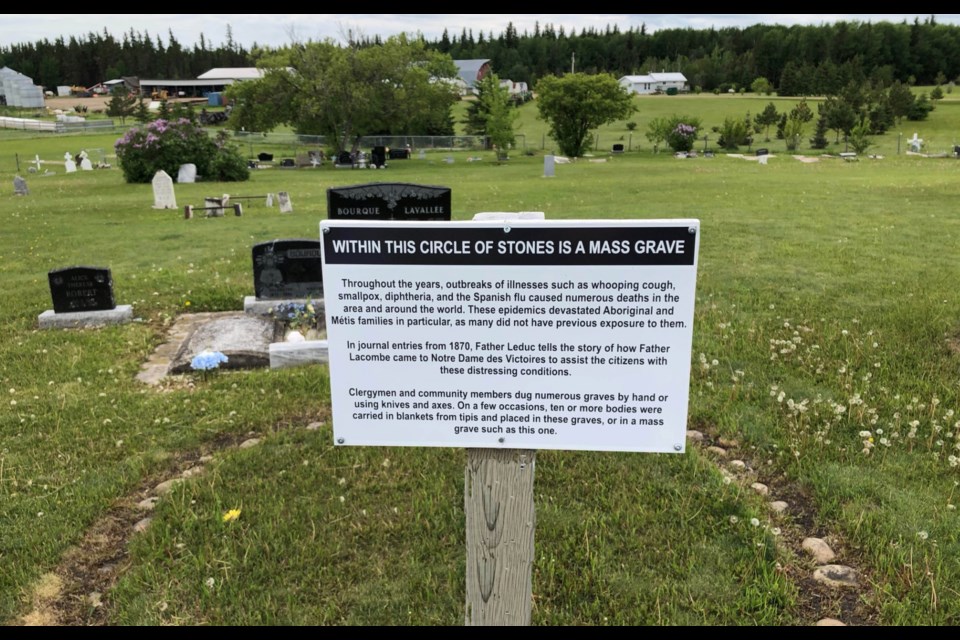LAC LA BICHE - It’s been a little over a year since ground-penetrating radar identified what is believed to be more than 200 unmarked graves on the property of a former residential school in Kamloops, B.C. The news lead to a national movement that linked the findings in Kamloops to other Canadian communities where residential schools had operated. From there, a connection has been made to the thousands of missing Indigenous children who attended 130 government and church-run Indian residential schools in Canada between 1831 and 1996.
The Lac La Biche Mission was one of those sites.
Shortly after last year’s findings, the Métis Nation of Alberta (MNA) Region 1 office organized a ceremony at the Mission site to honour the missing children and the tragic legacy of the residential school system. At that time, it was noted that the Mission property would also be explored for possible unmarked graves. The Mission cemetery now located across the main access road to the site, does have a marker identifying a mass gravesite. Mission officials have said that mass burial site was likely the result of sweeping pandemics that could have killed dozens, like the Spanish Flu outbreak in the early 1900s.
Current Lac La Biche Mission Historical Society President George L’Heureux remains committed to finding answers.
“Absolutely we are working on it,” he told Lakeland This Week, but added that funding for the project has been an issue. “The only problem is we’re a long way away from having it done."
For a period of five years during the late 1800s, the residential school at the Mission site was known as Notre Dame des Victoires. In 1898, the program was shut down and Indigenous youth were sent to the Blue Quills Sacred Heart Indian Residential School in Saddle Lake. That school operated until 1931.
Funding is needed
Currently, the provincial government has allocated $8 million for 25 former sites to apply across the province and the federal government has pledged $209 million over five years in support.
The Mission Historical Society members have spent the last year meeting with community groups, and have already filed for some of the federal and provincial grant funding.
While the society has taken advantage and applied, funding hasn't been approved yet compared, said L’Heureux, explaining that with less than 20 Indigenous students officially attending the Mission school in the five years it was in operation, it may not be a funding priority compared to longer-run schools with more students.
“The reason being is because it was only a residential school for five years in the late 1800s. Since it was such a short time and only 17 students attended, we are very low on the priority list for the ground-penetrating radar,” said L’Heureux, explaining that it is a priority for the society and community members. “We will eventually get it done, but of course, it’s all dependent on grants because there is no way the Society could pay for that... It’s very expensive and as a non-profit, and especially with the COVID-19 pandemic these last two years, we can barely keep the lights on.”
Healing
While the organization waits for funding and support, L’Heureux says the vision for the site will continue to build on awareness about the residential school system, the children, and acknowledgment of the residential school years as part of the overall history of the provincial and historic site. In fact, the society and community officials are also planning to create a visual tribute to the residential school history.
“We want to make a permanent memorial for all the children across Canada. We want to turn it into a place of healing,” he said, again raising the issue of funding, “but that it takes dollars so we're actively pursuing those avenues.”
The Mission will be holding a general meeting open to the public on the second Thursday of July. The gravesites topic and funding are on the agenda.
“Absolutely, anybody can attend at any time,” L’Heureux said.
In recent weeks, information regarding working being doing at the Saddle Lake Blue Quills Sacred Heart site has been released. Investigators point to at least 212 students having died at the school between 1898 and 1931.
*With files from Rob McKinley

.png;w=120;h=80;mode=crop)


